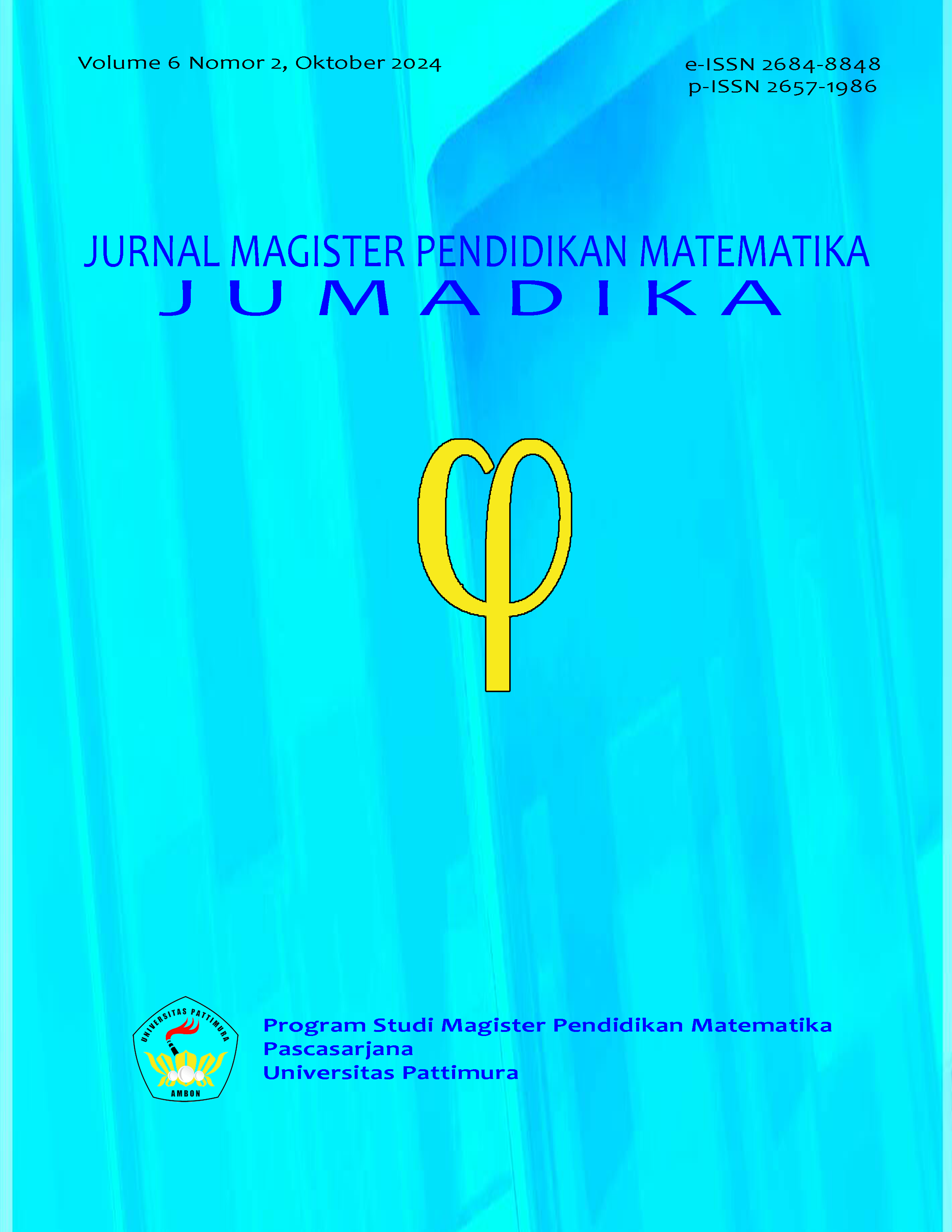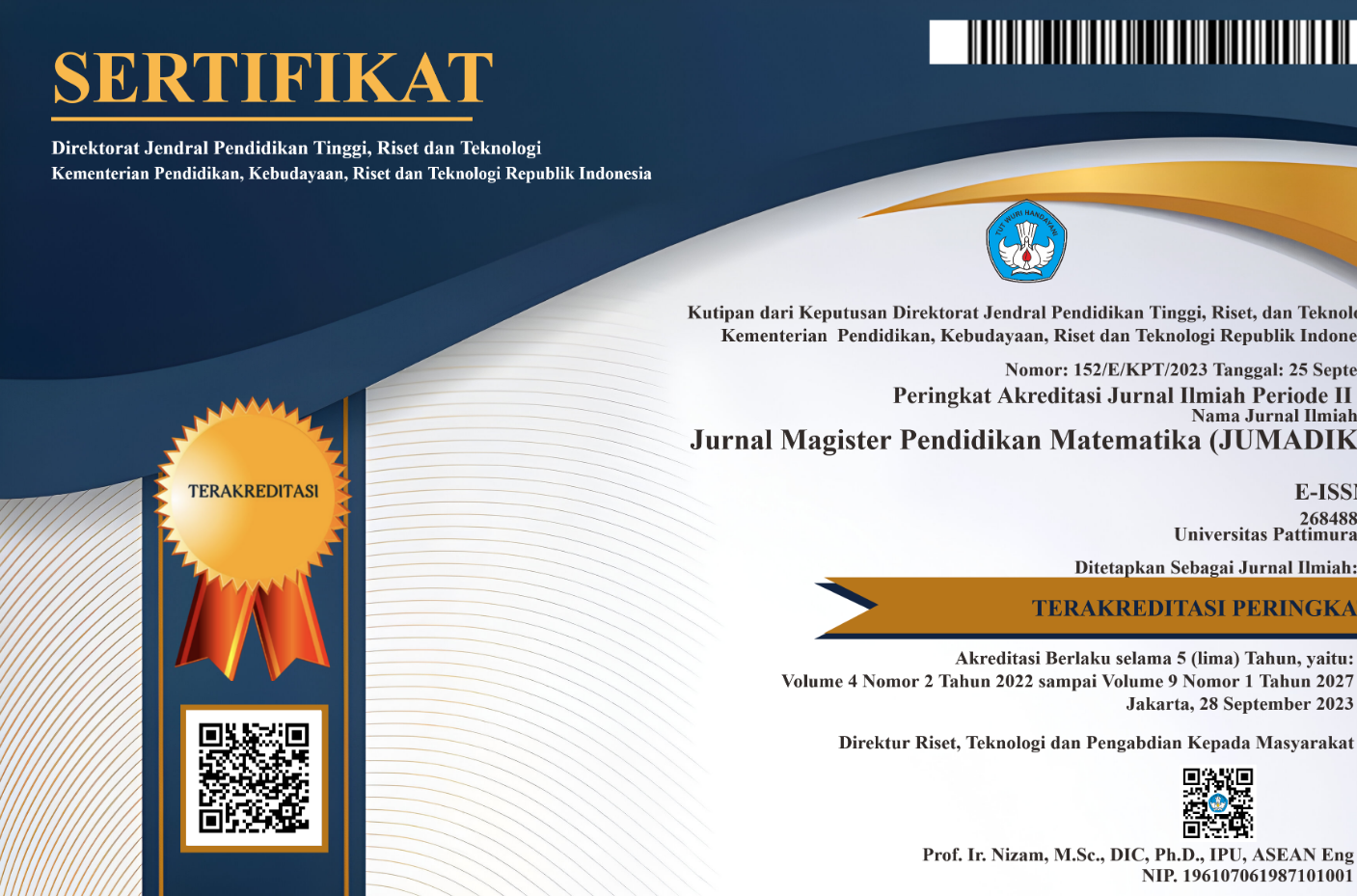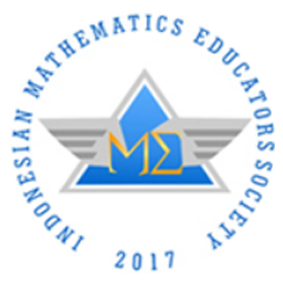MATHEMATICAL REPRESENTATION OF STUDENTS IN SOLVING CURVED-SIDED SPACE PROBLEMS IN TERMS OF LINGUISTIC, LOGICAL MATHEMATICAL AND VISUAL SPATIAL INTELLIGENCE
Abstract
One of the abilities needed in learning mathematics is solving mathematical problems. In learning mathematics, mathematical representations are needed by students in the problem solving process. Students tend to use mathematical representations, but sometimes do not understand what they are doing. In general, mathematical representation is also very instrumental in improving mathematical competence. In addition to representation, students also have intelligence, including linguistic, logical mathematical and visual spatial intelligence. This research is a descriptive qualitative research that aims to describe completely the mathematical representations of class IX students of SMP N 38 Central Maluku in solving curved-sided space building problems (tubes and cones) in terms of linguistic, logical mathematical and visual spatial intelligence. The instruments in this research are multiple intelligence questionnaire, test questions and interview guidelines. The subjects in this study were selected based on the results of filling out the intelligence questionnaire. The subjects chosen were CS with linguistic intelligence, JPT with mathematical logical intelligence and SRP with visual spatial intelligence. The validity of the data is done by using triangulation method, which is done by comparing the results of filling out the questionnaire, the results of the student problem solving ability test and the results of the interview. The results of this study are in the form of a description of the mathematical representations of class IX students of SMP N 38 Central Maluku in solving curved side room problems for each stage of problem solving according to Polya's stages.
Downloads
References
Ainsworth, Shaaron. 1999. The Functions of Multiple Representations. Computers & Education 33 (1999) 131-152.
Amstrong, Thomas. 2009. Multiple Intelligences in The Clasroom. USA: ASCD
Anonim. 2014. NCTM Proses Strandart: Representation. https://mathequality.wordpress.com/2014/01/1 2/nctm-process-standard-representation/ , diakses pada tanggal 6 Februari 2020.
Cheung, Kwok-Cheung. 2009. Reforming Teaching and Learning Using Theory of Multiple Intellegences: The Macao Experiences. Australia: Business Media B. V.
Depdiknas. 2006. Panduan Penyusunan Kurikulum Tingkat Satuan Pendidikan. Jakarta: Badan Standar Nasional Pendidikan.
Gangi, S. 2011. Differentiating Instruction using Multiple Intelligences in the Elementary School Classroom: A Literature Review. A Research Paper University of Wisconsin-Stout.
Irvaniyah, I., Akbar R. O., 2014. Analisis Kecerdasan Logis Matematis dan Kecerdasan Linguistik Siswa Berdasarkan Jenis Kelamin (Studi Kasus Pada Siswa Kelas XI IPA MA Mafatihul Huda). EduMa Vol.3 No.1 Juli 2014, ISSN: 2086 – 3918.
Kartini. 2009. Peranan Representasi dalam Pembelajaran Matematika. Sminar Nasional Matematika dan Pendidikan Matematika. ISBN: 978-979-16353-3-2.
Miles, M.B., Huberman, A.M., & Saldana, J. 2014. Qualitative Data Analysis (Third Edition). London: SAGE Publication.
Mink, D. V. 2010. Strategies for Teaching Mathematics. Shell Education Publishing, Inc. Huntington Beach.
Moleong, J. L. 2000. Metodologi Penelitian Kualitatif Edisi Revisi. Bandung: PT Remaja Rosdakarya.
Mustangin, 2015. Representasi Konsep dan Peranannya dalam Pembelajaran Matematika di Sekolah. Jurnal Pendidikan Matematika. Volume 1. Nomor 1. ISSN: 2442-4668.
Polya, G. 1973. How ti Solve it. Princeton, New Jersey: Princeton University Press.
Rosidah, L. 2014. Peningkatan Kecerdasan Visual Spasial Anak Usia Dini melalui Permainan Maze. Jurnal Pendidikan Usia Dini. Volume 8 Edisi 2.
Wijaya, P. P. 2019. Analisis Data Kualitatif Sebuah Tinjauan Teori dan Praktik. Edisi Pertama, cetakan ke-1. ISBN: 978-623-901515-7-0.
Winarto, P. 2010. Maximing Your Talent (Menemukan & Memakxsimalkan Potensi Diri Anda). Jakarta: libri, PT BPK Gunung Mulia.
Yaumi, M. 2015. Desain Strategi Pembelajaran untuk Mengembangkan Kecerdasan Verbal- Lingustik Peserta Didik. Auladuna. Vol.2, No.1.
Copyright (c) 2024 Marselina E Lepertery, Wilmintjie Mataheru, Carolina S Ayal

This work is licensed under a Creative Commons Attribution-NonCommercial-ShareAlike 4.0 International License.
License and Copyright Agreement
In submitting the manuscript to the journal, the authors certify that:
- They are authorized by their co-authors to enter into these arrangements.
- The work described has not been formally published before, except in the form of an abstract or as part of a published lecture, review, thesis, or overlay journal. Please also carefully read Jurnal Magister Pendidikan Matematika (JUMADIKA) Posting Your Article Policy.
- That it is not under consideration for publication elsewhere,
- That its publication has been approved by all the author(s) and by the responsible authorities – tacitly or explicitly – of the institutes where the work has been carried out.
- They secure the right to reproduce any material that has already been published or copyrighted elsewhere.
- They agree to the following license and copyright agreement.
Copyright
Authors who publish with Jurnal Magister Pendidikan Matematika (JUMADIKA) agree to the following terms:
- Authors retain copyright and grant the journal right of first publication with the work simultaneously licensed under a Creative Commons Attribution-NonCommercial-ShareAlike 4.0 International License (http://creativecommons.org/licenses/by-nc-sa/4.0/) that allows others to share the work with an acknowledgment of the work's authorship and initial publication in this journal.
- Authors are able to enter into separate, additional contractual arrangements for the non-exclusive distribution of the journal's published version of the work (e.g., post it to an institutional repository or publish it in a book), with an acknowledgment of its initial publication in this journal.
- Authors are permitted and encouraged to post their work online (e.g., in institutional repositories or on their website) prior to and during the submission process, as it can lead to productive exchanges, as well as earlier and greater citation of published work.








